Virginia Sale: Urbana's Hollywood Star
- Perry Morris
- Mar 3, 2022
- 11 min read
Updated: Mar 7, 2022
By Perry Morris
Cora Virginia Sale, the youngest child of Dr. Frank Orville Sale and Lillie Belle Partlow Sale, was born in Urbana, Illinois, on 20 May 1899.

Virginia Sale 1899-1992 (2006-019-289)
Frank (frequently referred to as F.O.) and Lillie Belle married in Potomac, Illinois, in 1881 and within months moved to the Dakota Territory as homesteaders. Virginia’s three older siblings, Edna, Charles ‘Chic,’ and Dwight, were born in Huron, South Dakota. The family returned to Urbana, Illinois in 1894.
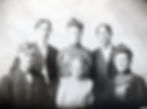
An early photo of the Sale Family. In back, from left: Charlie, Edna, and Dwight. In front, from left: Dr. Frank Orville Sale, Virginia, and Lillie Belle. (2006-019-087)
Frank was a dentist. Lillie Belle was a poet and acted as the truant officer for the Urbana schools for several years. Both were active in their church and community.
Edna got a degree in speech/drama from Northwestern University and gave readings of poetry and prose before her marriage. In later years, she took up painting.
Charlie, as the family called him, quit school at age 15. He worked for a while at the Big Four yards in Urbana. Building on his ability to make people laugh, he honed his skills and began doing impersonations on the vaudeville circuit and made several movies. He is well known for his book “The Specialist” based on one of his monologues.

Right: Portrait of Charles ‘Chic’ Sale that he inscribed to his “dear little sister Virginia.” (2006-019-062)
Dwight attended the University of Illinois for one year. He was also a talented comic and storyteller. For a short time, he was a reporter for the Courier and then the Gazette. He spent some time in Ordway, Colorado, then worked on the Urbana Chautauqua grounds. He accepted a good offer to work in mining at Bisbee, Arizona. He was killed in a mining accident at the age of 20.
Virginia, after graduating high school in 1917, attended the University of Illinois for two years. She joined the Delta Gamma sorority and the Zeta Phi Eta honorary speech sorority. She decided she wanted to go on stage and convinced the family to send her to the American Academy of Dramatic Arts in New York City.
After graduating, she had little luck finding a job. She finally got a little walk-on in “Montmartre” and one line in “Lightnin’” and worked as a waitress to afford to eat. While she was struggling in New York, Virginia met a young actor named Sam Wren. She instantly fell in love. It took Sam a few more years.
Virginia appeared in vaudeville shows two separate times at the Orpheum Theatre in Champaign. The first, in 1921, was co-written with her brother Charlie (Chic). The second was in 1925.

Two Orpheum ads from 1921 where Virginia appears in a sketch called “Red and Yellow.”

The family convinced Virginia to return to Urbana. They then suggested she go to Hollywood, likely influenced by Chic's success there, buying her a ticket and giving her $100. She arrived in Los Angeles in early January 1927, and got some jobs as an ‘extra,’ but there were still weeks without a call. Virginia related this story in a 1931 interview in The Kansas City Star: “I had known in New York an assistant director who introduced me to King Vidor, then casting for “The Crowd.” He gave me quite a good bit in the picture, although it lasted only five days. When asked how much salary I wanted, Ned told me to say $350 a week. ‘Well, I think you ought to work for us for $25 a day,’ the casting director said. That’s an awful comedown, I protested, trembling in my boots. ‘All right then, let’s compromise on $35 a day,’ he said. I was awfully glad to get it.” ($35 would be $565.53 in 2022).

Virginia Sale with King Vidor (2006-019-172)
“The Crowd” was shot in 1927 but not released until 1928. Virginia also had the part of Fifi in “Legionnaires in Paris” shot and released in 1927. She also got a good part in Vilma Banky’s “So This Is Heaven.” She refused to take advantage of being Chic Sale’s sister to get work. Through hard work and her own initiative, she got more and more jobs, increasingly as ‘old ladies and other characters. The Internet Movie Database lists five films released in 1928 then nine in 1929. This wouldn’t have included work as an extra.
Virginia lived at the Hollywood Studio Club during her first two years in California.

Cary Grant with Virginia Sale and Constance Bennette on the set of "Topper" promoting a Toy Loan program in 1937. (2006-019-010)

Hollywood Studio Club at dinner. Virginia is second from the left. (2006-019-116)
Virginia continued her movie career playing character roles and performed at the Hollywood Canteen. She was in 54 films released between 1930 and 1935.
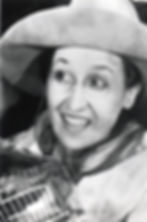
“The Dude Wrangler,” in which a young urban dandy takes a job at a dude ranch to prove his manliness to the girl he loves, came out in 1930. Virginia plays a ranch guest in this early talkie.
Virginia Sale in her role as a dude ranch guest in “Dude Wrangler” (2006-019-271)
Virginia played Marie, Joan’s Maid, in “Lovin’ the Ladies,” also released in 1930. The film’s premise is that Jimmy Farnsworth (Allen Kearns) bets his friend $5,000 that he can get any two people, under the proper environment, to fall in love and become engaged within a month. It starred Richard Dix as Peter and Lois Wilson as Joan. As it happens, this was the first film shown at The Virginia Theatre when RKO took over operations.

Virginia Sale as Marie, Joan’s Maid, and Richard Dix as Peter in “Lovin’ the Ladies” (2006-019-170)
Virginia Sale played Smitty in “Many a Slip” released in 1931. It was a comedy that centered on the question of whether a man’s wife is or is not pregnant.

Slim Summerville and Virginia Sale in a scene from “Many a Slip” (2006-019-277)
“Madame DuBarry” was a historical film loosely based on the life of Madame Du Barry, the last mistress of King Louis XV of France. It was released in 1934 and starred Delores del Rio as Du Barry and Reginald Owen as Louis.

Virginia as Sophie, one of the King’s daughters in “Madame DuBarry” (2006-019-015)
“Those We Love” was an NBC radio serial about the small-town life of two modern youngsters in New England. Virginia Sale voiced the role of Martha, the maid for eight years every Sunday. There does not appear to be any connection between the radio show and the 1932 movie by the same name in which Virginia had a small part.

“Those We Love” cast members include (pictured from left to right): Martha, the maid (Virginia Sale), Kathy (Nan Grey), Dr, Foster (Donald Woods), and Amy (Ann Todd).
Sam Wren was a stage and film actor. He played in summer stock and was on Broadway with the Theatre Guild before going to Hollywood where the two met again. Sam and Virginia spent time in both New York and Hollywood for work.
Sam Wren and Virginia Sale married 2 April 1935 at the home of her brother Charlie and sister-in-law Marie in Beverly Hills, California. Virginia had gone to Hollywood at the behest of the Fox Studio to work in pictures. The couple would be based in New York.
Sam Wren served in the Air Corps in World War II then served a six-year stint as executive secretary of Actor’s Equity. He also produced and directed, and was an executive at both Warner Brothers and Columbia Studios. He acted as Virginia’s personal representative (agent).
Virginia’s movie roles picked up again, but with supporting roles, she generally wasn’t required on set as much as the leads, depending on the role of course. She was also doing radio work. Virginia had taken up doing her one-woman shows to have work between her radio and movie roles. They proved immensely popular and took her on tour all over the country. She gave over 6,000 performances in the US, Europe, and to the armed forces during the war.
Virginia gave up her road show when the twins were born in 1936. That didn’t last long as she gradually took on more and more bookings.
We’ll talk more about Virginia’s characters and the one-woman shows later.
Virginia played the part of a townsperson named Meg in “Badman’s Territory” released in 1946. The James Gang, after some gunplay with a posse, head for Quinto in a section of land not part of the US. Anyone there is out of the reach of the law, so the town is filled with outlaws.
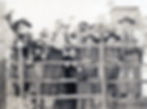
A still from “Badman’s Territory” (1946) showing a group of townsfolk. (2006-019-279)
The Wrens signed a contract in March 1949 with ABC TV for a new suburban life television show called “The Wren’s Nest.” All four of the family members, Virginia as Mama, Sam as Papa, and the 13-year-old twins Chris and Ginny, appear in the 15-minute show. Virginia wrote the scripts based on incidents that actually happened to the family. The broadcasts originated from a studio in New York City where the set was designed as a corner of the family living room. The show was a pioneer in a new genre of family situation comedies. The series ran for forty-seven episodes.

On the “Wren’s Nest” set (2006-019-190)
One reason the Wrens thought up the television show was because Virginia’s touring had built back up to an exhausting pace. The show allowed them to live and work in one place and to be closer to the children.
Virginia played more than 300-character parts in the movies. Her movie jobs dwindled in the 1940s with a few in the 1950s to be replaced by television work. She had a part in “One Man’s Way” in 1964 and “How to Succeed in Business Without Really Trying” in 1967.
The last movie credit listed in IMDb was for the role of a Bingo Caller in “Slither” in 1973. The film’s story was about a car thief on parole from prison intending to go straight, but ends up in a wild goose chase for stolen cash, along with a small-time band leader and his wife, and a friendly free-spirited woman.
Virginia Sale appeared in at least 200 TV shows including as a guest for six-months on the old Kate Smith Show and 24 times on Garry Moore’s show. She did an episode of “Lux Video Theatre” in 1951, and she was doing the TV show “Fairmeadows, USA.” in 1952. In 1960, she did episodes of “Tales of Wells Fargo” and “The Many Loves of Dobie Gillis.”
The Wrens had just moved back to Hollywood from their Marlo, New Hampshire, home when Sam became ill and died at age 65 in March 1962.
Virginia settled for good in Hollywood. She hired a new agent who began getting Virginia parts in commercials, print ads, and more TV shows.
Virginia Sale made a lot of TV appearances in the 1960s. In 1964 she was in episodes of “Ben Casey” and “The Beverly Hillbillies.” In 1965, she appeared in “Bob Hope Presents: The Chrysler Theatre” and “The Wild, Wild West.” In 1966, she appeared in “Green Acres” and “Love On a Rooftop,” then in 1967 an episode of “I Spy.” She appeared twice on “The Andy Griffith Show.” Once in 1964 and again in 1966. Her most frequent appearance was as Selma Plout on “Petticoat Junction.” Twice in 1964, three times in 1965, and once each in 1966 and 1969. The last TV credit in IMDb is a 1975 appearance on “Police Woman.”
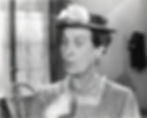
Virginia as Selma Plout (2006-019-205)
Virginia Sale also did quite a bit of commercial work. Here are two examples:

Virginia (right) in a Mountain Dew commercial. (2006-019-204)
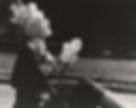
Virginia as an elderly lady driving an ‘invisible’ car in a Gulf Oil commercial. (2006-019-339)

Virginia Sale Wren died from heart failure on 23 August 1992 at age 93. She had been living at the Motion Picture and Television Country House in Woodland Hills, California. She was buried next to her husband in Arlington National Cemetary with a small graveside service that included her daughter Ginny reading a poem that Virginia’s mother Lillie Belle had written to Virginia in 1937.
Virginia Sale Wren as herself in February 1978 (2006-019-282)
The Characters and One-Woman-Shows
Virginia created a stable of twenty or more characters and wrote monologues for them.
Virginia possessed a remarkable talent to create characters using her facial expressions and vocal nuances. She added appropriate costumes, makeup, and maybe a wig, glasses, or a cane.
In a 1975 story in the Los Angeles Times, Virginia said “I can do an accent from any part of the country except New York’s Brooklynese. I never could do that. I guess because I don’t understand it.” Interestingly, her husband Sam Wren was from Brooklyn, but had lost his accent by the time they met.
Virginia Sale mostly performed on a bare stage, maybe a chair or table and a few hand props. She chose five or so monologues to present in each of the “Americana” productions. The remainder of the evening would be the longer “Dakota Fever” monologues. There was also an accompanist and a musical interlude or two.

Virginia as two of her characters (2006-019-155& 2006-019-157)
Here’s just a sampling of Virginia’s sketches and their characters:
“Traveling on the Illinois Central” Virginia portrays a mother trying to keep her unruly son under control, traveling from Rantoul to Gilman, going home after a visit with relatives.
In the “Life of the Party,” Virginia portrays a giggling, always talking young woman who annoys rather than impresses the new man in town.

“Mealtime in Indiana” finds Virginia impersonating an Indiana housewife trying to get ready for the Ladies Guild and still serve her family their dinner.
“Three O’clock in the Morning” finds Virginia as the weary hostess trying to hasten the departure of guests who have overstayed their welcome.
“I Remember Abraham Lincoln” has Virginia as the elderly Grandma Willoughby reminiscing to her young visitor about Abraham Lincoln.
Miss Sale portrayed four different characters in her “Husbands’ Night at the Ladies’ Monday Morning club.” With a change of hat and facial expression, she switched from the rasping voice president to the buck-toothed treasurer, who fumbled in her purse for her report, found her grocery list and a betting ticket, and then reported extemporaneously that the club had $3 and some cents, mostly in I.O.U.’s and a Dewey button; the twittering visitation and cheering up chairman, who said her job depressed her; and the guest speaker on charm, who simply blubbered with personality.

One of Virginia’s most popular acts was her imitation of Chic, with his ambling walk, horn-tooting, tobacco chewing, and comic slapstick. She never put it in the printed program but often used it as an encore.
Virginia as her brother Chic’s character (2006-019-160)
Virginia performed her one-woman show “Americana” in Champaign and Urbana twice. Once in 1947 at the University Auditorium then again at the Champaign Junior High School in 1952.

Program for Virginia’s 26 March 1947 show at the University Auditorium
Miss Sale presented her 1952 appearance as a memorial show for her parents, the late Doctor and Mrs. F.O. Sale, well known Urbana couple.

Program from the 25 February 1925 show signed by Virginia.
Annabel Schmelzle described the February 1952 show in The News-Gazette: Virginia “appeared on the stage first in a beautiful blue strapless formal. She explained that she usually comes out as a ‘fuddy old character but since I’m home, I wanted to be pretty as I can.’ And she was pretty. Her later characterizations as old women and busy bodies really proved her gift of talent in mimicry.”
The “audience loved her mention of local folks, such as Flossie Wiley, Marion Stuart, Alma Yearsley, C. Ross Mills, Glenn Gordon, Leona Bigler, and Gladys Barr in her skits. She mentioned Tom Garman as “one of our brighter students” in a school room debate and berated Julius Cohen, her accompanist for the evening, for his antics in the classroom.”
During the intermission, Miss Sale was presented a bouquet of roses from Delta Gamma of which she is a member on the UI campus.
James Elmo Smith, whom Virginia said was “one of the best friends Mom and Pop ever had,” gave an informal eulogy to Doctor and Mrs. Sale. He cited their work in church and community affairs; and read two poems written by Mrs. Sale.

Virginia with a bouquet of roses

“Dakota Fever” follows Anne Robbins’ life from her marriage in Illinois in 1880 through the suffering endured in settling the Dakotas. Virginia Sale wrote the monologues using her Aunt Anne Robbins’ diary of her time in the Dakota Territory. She used the device of an eighty-year-old woman reminiscing to a neighbor in 1940 about the anticipated birth of her first child; the

hardships of the journey; the waiting alone in a blizzard while the men, who had gone for supplies became lost; the rejoicing over a good crop which, before it could be harvested, was devastated by a tornado; the trauma of a prairie fire which takes the lives of a young couple who came west with them; and the final decision and resignation of remaining to be buried at the side of her husband.
Two of the characters from “Dakota Fever” (2006-019-295 and 2006-019-297)
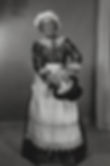
“The Women in Lincoln’s Life” was a later group of related monologues written for Virginia by Ramon Romero. Virginia became intrigued by a play called “Mrs. Lincoln” written by Ramon Romero that she had seen in Hollywood. She and Sam were living in New York at the time, but she wrote to Romero about the possibility of turning it into a monologue for her. Many years later, their paths crossed again when they discovered they were neighbors living in Hollywood, and the project was revived. Virginia portrays Nancy Hanks, Sarah Lincoln, Ann Rutledge, Mary Owens, and Mary Todd Lincoln.
Virginia Sale as Sarah Bush (left) (2006-019-124)

Virginia Sale in "The Women in Lincoln's Life"
(2006-019-122)

Virginia Sale in "The Women in Lincoln's Life"
(2006-019-123)
.jpg)

























